牛津译林版模板5 Unit2 Environment Grammar 课件 38张PPT
文档属性
| 名称 | 牛津译林版模板5 Unit2 Environment Grammar 课件 38张PPT | 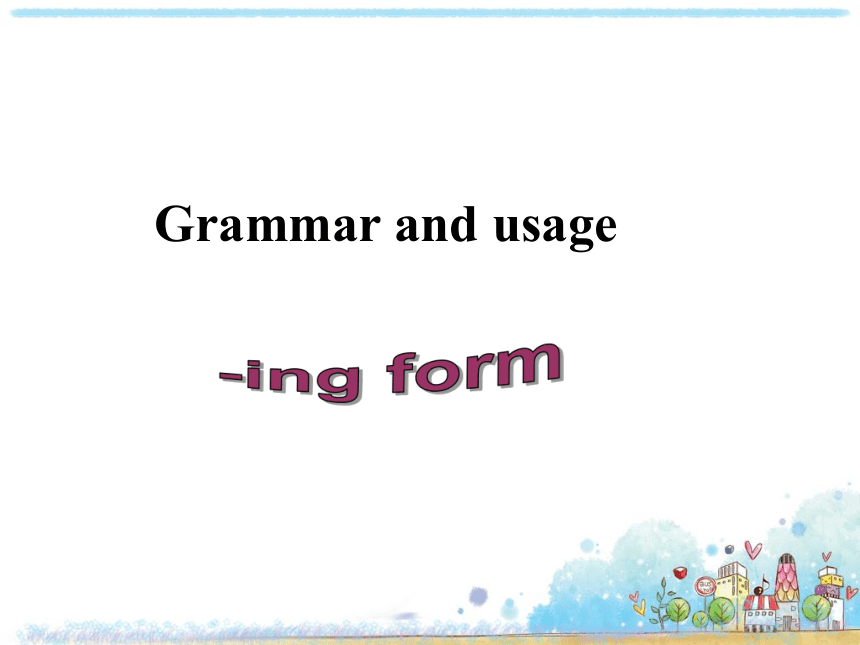 | |
| 格式 | zip | ||
| 文件大小 | 1.6MB | ||
| 资源类型 | 教案 | ||
| 版本资源 | 牛津译林版 | ||
| 科目 | 英语 | ||
| 更新时间 | 2020-04-30 22:27:30 | ||
图片预览

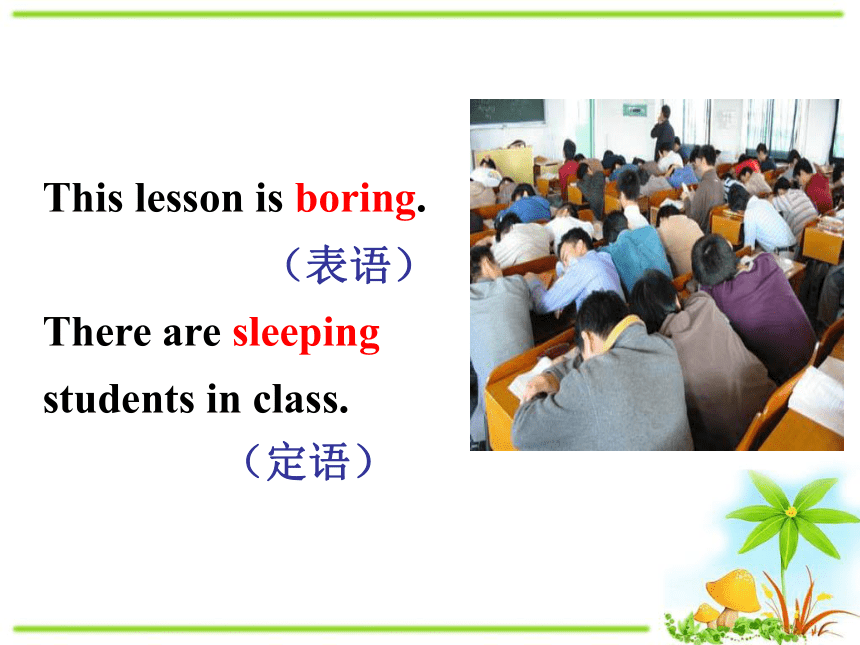
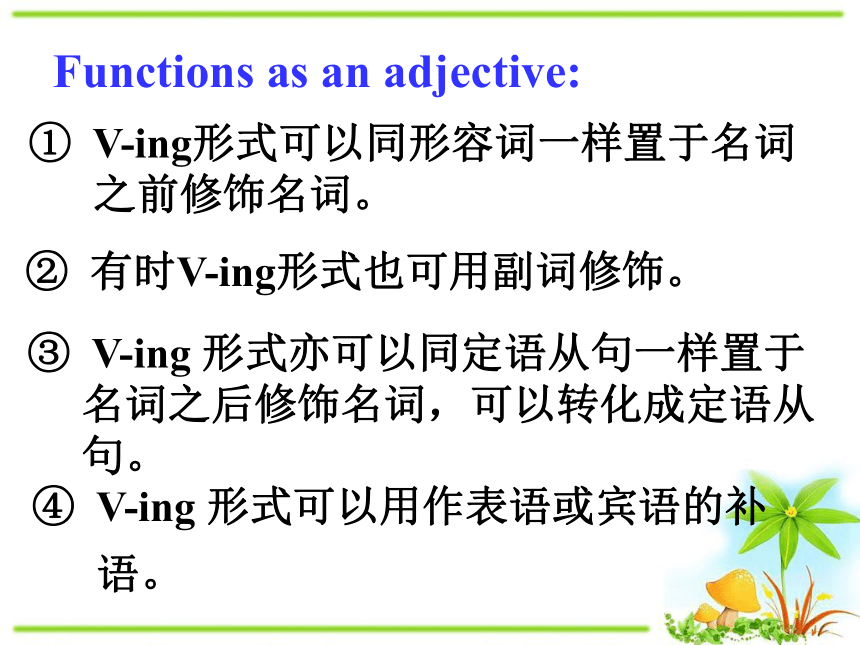
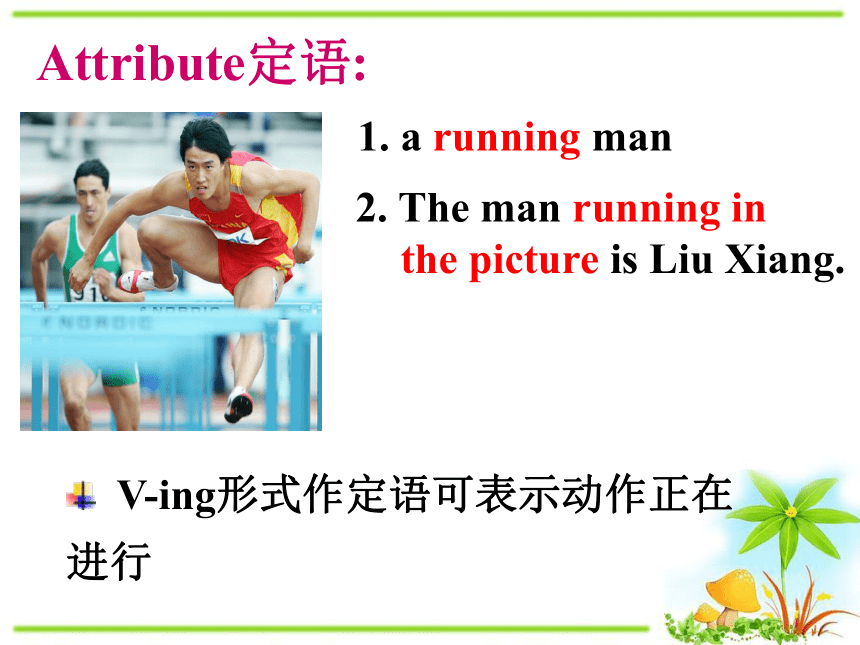
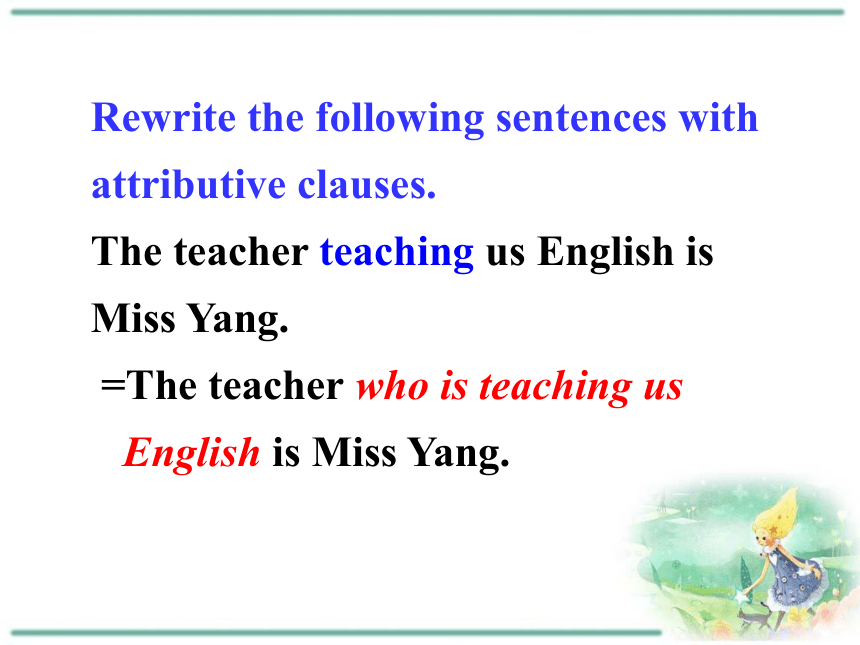



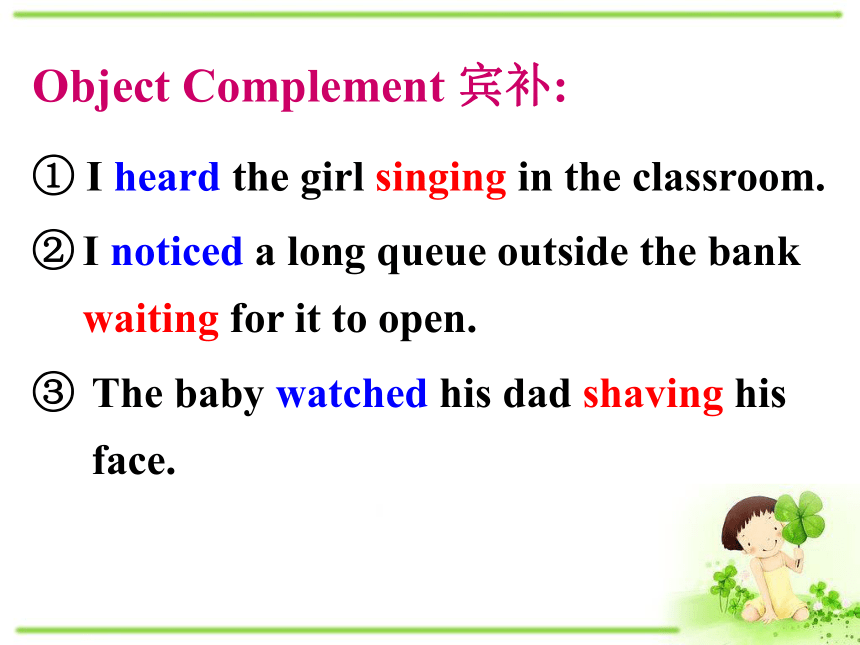
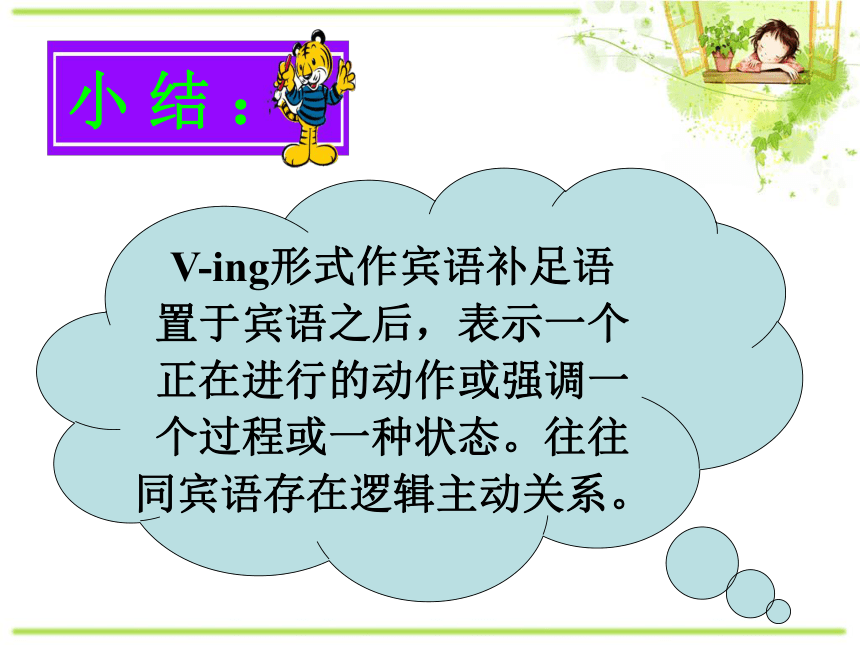


文档简介
(共38张PPT)
Grammar and usage
This lesson is boring.
There are sleeping students in class.
(表语)
(定语)
Functions as an adjective:
V-ing形式可以同形容词一样置于名词
之前修饰名词。
有时V-ing形式也可用副词修饰。
V-ing 形式亦可以同定语从句一样置于
名词之后修饰名词,可以转化成定语从
句。
V-ing 形式可以用作表语或宾语的补
语。
2. The man running in
the picture is Liu Xiang.
1. a running man
Attribute定语:
V-ing形式作定语可表示动作正在进行
Rewrite the following sentences with attributive clauses.
The teacher teaching us English is Miss Yang.
=The teacher who is teaching us
English is Miss Yang.
The people sitting behind us are all teachers.
The expert coming from Guizhou is a lady
called Miss Cai.
=The people who are sitting behind
us are all teachers.
=The expert who comes from Guizhou is a
lady called Miss Cai.
Translate the following phrases.
a reading room
a washing machine
an exciting evening
an interesting crosstalk
阅览室
洗衣机
激动人心的夜晚
有趣的相声
a sleeping car
a smoking room
listening practice
an opening speech
a booking office
running water
卧铺车
吸烟室
听力练习
开幕词
售票处
自来水
I heard the girl singing in the classroom.
I noticed a long queue outside the bank waiting for it to open.
Object Complement 宾补:
The baby watched his dad shaving his face.
V-ing形式作宾语补足语置于宾语之后,表示一个正在进行的动作或强调一个过程或一种状态。往往同宾语存在逻辑主动关系。
小 结 :
V-ing词组可以在句中充当时间、原
因、结果、条件等状语。
1. 作时间状语
-ing短语作时间状语要置于句首。如:
Hearing the bad news, they couldn’t help crying.
=When they heard the bad news, they couldn’t help crying. 当听到这个不幸的消息时,他们情不自禁地哭了起来。
Having received his letter, I decided to write back. =After I had received his letter, I decided to write back. 收到他的信后,我决定给他回信。
2. 作原因状语
可以和as/since/because等引导的原因状语从句互换。
-ing短语作原因状语置于句首。如:
Being so angry, he couldn’t go to sleep.
=Because he was so angry, he couldn’t go to sleep. 因为太生气了,他不能入睡。
Having been to the Great Wall many times, he didn’t go last week. =Because (As) he had been to the Great Wall many times, he didn’t go last week. 因为他已经去过长城许多次,上周他就没去。
3. 作条件状语,可以与if引导的条件状语从句互换。
-ing作条件状语置于句首或句末。如:
Working hard, you will succeed. =If you work hard, you will succeed. 如果你勤奋一点,你就会成功。
Being given more attention, the trees could have grown better.
=If they had been given more attention, the trees could have grown better. 如果对这些树再多注意些,它们可能长得更好。
4. 作让步状语
-ing短语作让步状语,可置于句首或 句末,常与even if, though,although等 连用。如:
Though working from morning till night, his father didn’t get enough food.
=Although his father worked from morning till night, he didn’t get enough food.
虽然他父亲从早到晚拼命地干活,但是他还是挣不到足够的吃的。
5. 作伴随状语,现在分词所表示的动作与谓语动词所表示的动作同时发生。
置于句首或句末。如:
They came into the classroom, singing and laughing. =They sang and laughed; they came into the classroom. 他们又唱又笑地走进教室。
When working in the factory, he was
an good worker.
=When he worked in the factory, he
was an good worker.
注意:
1. -ing短语与when, while, though, until, if等连词连用时,相当于这些连词引导的一个从句。如:
Though willing to attend the party, he
refused the invitation.
=Though he was willing to attend the
party, he refused the invitation.
While staying in Beijing, he came to see
me twice.
=While he was staying in Beijing, he
came to see me twice.
If playing all day, you will waste
your valuable time.
=If you play all day, you will waste
your valuable time.
Though raining heavily, it cleared up very soon.
=Though it was raining heavily, it
cleared up very soon.
2. 动词-ing形式在句中作状语时,其逻辑主语与主句的主语保持一致。如:
He traveled on the plane like this, keeping the tortoise hidden in a blanket.
= When he traveled on the plane like this, he kept the tortoise hidden in a blanket.
小 结:
V-ing有其完成式having done, 表示分
词动作发生于主句动作之前。
表示时间状语时常同连词when,
whenever, while, once, until等连用。
分词作状语时,其逻辑主语同主句的主
语一致且有逻辑主动关系,往往可转换
为相应的状语从句。
V-ing形式的否定not要置于V-ing之前。
2. Looking back, I find I didn’t like some of the questions the audience asked though.
3. hearing what you said about the enviroment and the economy needing to work together more, I was very impressed.
P31
4. You made that powererful statement, impressing the audience.
5. having talked to you today, I think we should work on some projects together.
1. a. Hearing the news, tears ran down her face.
b. Hearing the news, she cried out sadly.
2. a. Entering the classroom, I found nobody in it.
b. Entering the classroom, nobody was found in it.
Choose the correct sentence.
3. a. Looking out through the window, the garden was beautiful.
b. Looking out through the window, we saw a beautiful garden.
4. a. Reading the evening newspaper, a dog started barking.
b. I was reading the evening newspaper when a dog started barking.
5. a. Being fine, we will have the sports meeting next week.
b. It being fine, we will have the sports meeting next week.
-ing形式的否定式为在其前面加not。
如:
He sat there, not knowing what to say.
[考例] We often provide our children with toys, footballs or basketballs, _____ that all children like these things. (2009全国卷III)
A. thinking B. think C. to think D. thought
[点拨] 选A。we 与think 之间是逻辑上的主谓关系。句子相当于:We often provide our children with toys, footballs or basketballs, because we think that all children like these things.
3. He travelled on the plane like this, keeping the tortoise hidden in a blanket. (P30)
[考点] 当分词作状语时,分词的逻辑主语必须与句子的主语保持一致。
[考例] While watching television, _____. (2009全国卷II)
A. the doorbell rang
B. the doorbell rings
C. we heard the doorbell ring
D. we heard the doorbell rings
[点拨] 选C。由前面分词结构While watching television可以看出:watching television是由人发出的动作,其主语应当是和主句的逻辑主语一致的,所以主句的主语应该是人。
Hear…do/ hear…doing 听到…
4. He sat there, not knowing what to say. (P30)
[考点] 非谓语动词的否定形式是在非谓语动词前面加上not。
[考例] _____ the programme, they have to stay there for another two weeks.
由于没有完成课程,他们不得不在那里再待两周。
Not completing
B. Not completed
C. Not having completed
D. Having not completed
[点拨] 选C。该句主语是they,和complete 是逻辑上的主谓关系,所以用V-ing形式表示主动。complete the programme这个动作发生在have to stay there ... 动作之前,故用完成时态。
Grammar and usage
This lesson is boring.
There are sleeping students in class.
(表语)
(定语)
Functions as an adjective:
V-ing形式可以同形容词一样置于名词
之前修饰名词。
有时V-ing形式也可用副词修饰。
V-ing 形式亦可以同定语从句一样置于
名词之后修饰名词,可以转化成定语从
句。
V-ing 形式可以用作表语或宾语的补
语。
2. The man running in
the picture is Liu Xiang.
1. a running man
Attribute定语:
V-ing形式作定语可表示动作正在进行
Rewrite the following sentences with attributive clauses.
The teacher teaching us English is Miss Yang.
=The teacher who is teaching us
English is Miss Yang.
The people sitting behind us are all teachers.
The expert coming from Guizhou is a lady
called Miss Cai.
=The people who are sitting behind
us are all teachers.
=The expert who comes from Guizhou is a
lady called Miss Cai.
Translate the following phrases.
a reading room
a washing machine
an exciting evening
an interesting crosstalk
阅览室
洗衣机
激动人心的夜晚
有趣的相声
a sleeping car
a smoking room
listening practice
an opening speech
a booking office
running water
卧铺车
吸烟室
听力练习
开幕词
售票处
自来水
I heard the girl singing in the classroom.
I noticed a long queue outside the bank waiting for it to open.
Object Complement 宾补:
The baby watched his dad shaving his face.
V-ing形式作宾语补足语置于宾语之后,表示一个正在进行的动作或强调一个过程或一种状态。往往同宾语存在逻辑主动关系。
小 结 :
V-ing词组可以在句中充当时间、原
因、结果、条件等状语。
1. 作时间状语
-ing短语作时间状语要置于句首。如:
Hearing the bad news, they couldn’t help crying.
=When they heard the bad news, they couldn’t help crying. 当听到这个不幸的消息时,他们情不自禁地哭了起来。
Having received his letter, I decided to write back. =After I had received his letter, I decided to write back. 收到他的信后,我决定给他回信。
2. 作原因状语
可以和as/since/because等引导的原因状语从句互换。
-ing短语作原因状语置于句首。如:
Being so angry, he couldn’t go to sleep.
=Because he was so angry, he couldn’t go to sleep. 因为太生气了,他不能入睡。
Having been to the Great Wall many times, he didn’t go last week. =Because (As) he had been to the Great Wall many times, he didn’t go last week. 因为他已经去过长城许多次,上周他就没去。
3. 作条件状语,可以与if引导的条件状语从句互换。
-ing作条件状语置于句首或句末。如:
Working hard, you will succeed. =If you work hard, you will succeed. 如果你勤奋一点,你就会成功。
Being given more attention, the trees could have grown better.
=If they had been given more attention, the trees could have grown better. 如果对这些树再多注意些,它们可能长得更好。
4. 作让步状语
-ing短语作让步状语,可置于句首或 句末,常与even if, though,although等 连用。如:
Though working from morning till night, his father didn’t get enough food.
=Although his father worked from morning till night, he didn’t get enough food.
虽然他父亲从早到晚拼命地干活,但是他还是挣不到足够的吃的。
5. 作伴随状语,现在分词所表示的动作与谓语动词所表示的动作同时发生。
置于句首或句末。如:
They came into the classroom, singing and laughing. =They sang and laughed; they came into the classroom. 他们又唱又笑地走进教室。
When working in the factory, he was
an good worker.
=When he worked in the factory, he
was an good worker.
注意:
1. -ing短语与when, while, though, until, if等连词连用时,相当于这些连词引导的一个从句。如:
Though willing to attend the party, he
refused the invitation.
=Though he was willing to attend the
party, he refused the invitation.
While staying in Beijing, he came to see
me twice.
=While he was staying in Beijing, he
came to see me twice.
If playing all day, you will waste
your valuable time.
=If you play all day, you will waste
your valuable time.
Though raining heavily, it cleared up very soon.
=Though it was raining heavily, it
cleared up very soon.
2. 动词-ing形式在句中作状语时,其逻辑主语与主句的主语保持一致。如:
He traveled on the plane like this, keeping the tortoise hidden in a blanket.
= When he traveled on the plane like this, he kept the tortoise hidden in a blanket.
小 结:
V-ing有其完成式having done, 表示分
词动作发生于主句动作之前。
表示时间状语时常同连词when,
whenever, while, once, until等连用。
分词作状语时,其逻辑主语同主句的主
语一致且有逻辑主动关系,往往可转换
为相应的状语从句。
V-ing形式的否定not要置于V-ing之前。
2. Looking back, I find I didn’t like some of the questions the audience asked though.
3. hearing what you said about the enviroment and the economy needing to work together more, I was very impressed.
P31
4. You made that powererful statement, impressing the audience.
5. having talked to you today, I think we should work on some projects together.
1. a. Hearing the news, tears ran down her face.
b. Hearing the news, she cried out sadly.
2. a. Entering the classroom, I found nobody in it.
b. Entering the classroom, nobody was found in it.
Choose the correct sentence.
3. a. Looking out through the window, the garden was beautiful.
b. Looking out through the window, we saw a beautiful garden.
4. a. Reading the evening newspaper, a dog started barking.
b. I was reading the evening newspaper when a dog started barking.
5. a. Being fine, we will have the sports meeting next week.
b. It being fine, we will have the sports meeting next week.
-ing形式的否定式为在其前面加not。
如:
He sat there, not knowing what to say.
[考例] We often provide our children with toys, footballs or basketballs, _____ that all children like these things. (2009全国卷III)
A. thinking B. think C. to think D. thought
[点拨] 选A。we 与think 之间是逻辑上的主谓关系。句子相当于:We often provide our children with toys, footballs or basketballs, because we think that all children like these things.
3. He travelled on the plane like this, keeping the tortoise hidden in a blanket. (P30)
[考点] 当分词作状语时,分词的逻辑主语必须与句子的主语保持一致。
[考例] While watching television, _____. (2009全国卷II)
A. the doorbell rang
B. the doorbell rings
C. we heard the doorbell ring
D. we heard the doorbell rings
[点拨] 选C。由前面分词结构While watching television可以看出:watching television是由人发出的动作,其主语应当是和主句的逻辑主语一致的,所以主句的主语应该是人。
Hear…do/ hear…doing 听到…
4. He sat there, not knowing what to say. (P30)
[考点] 非谓语动词的否定形式是在非谓语动词前面加上not。
[考例] _____ the programme, they have to stay there for another two weeks.
由于没有完成课程,他们不得不在那里再待两周。
Not completing
B. Not completed
C. Not having completed
D. Having not completed
[点拨] 选C。该句主语是they,和complete 是逻辑上的主谓关系,所以用V-ing形式表示主动。complete the programme这个动作发生在have to stay there ... 动作之前,故用完成时态。
